
The winged keel is a sailboat keel layout first fitted on the 12-metre class yacht Australia II , 1983 America's Cup winner.

The winged keel is a sailboat keel layout first fitted on the 12-metre class yacht Australia II , 1983 America's Cup winner.
This layout was adopted by Ben Lexcen, designer of Australia II . Although Ben Lexcen "had tried the winged keel idea before", [1] there is conjecture that it was computed and designed by a Dutch aerodynamicist at the Wageningen towing tank (Netherlands Ship Model Bassin). [2] [3] [4]
The lateral wings of Australia II are of moderate aspect ratio, forming a nearly horizontal foil, the "wing", at the bottom to provide additional effective span, in the same way as the winglets on an aircraft. [3] [5] Each wing acts as a winglet, effectively increasing the keel aspect ratio therefore reducing the lift-induced drag. Because the yacht is heeled over when sailing upwind, the leeward foil attains more draft, which reduces the loss of efficiency that always occurs under heel. The wings were canted downwards at about 20 degrees, in order to promote proper hydrodynamic loading (lift) on each wing when sailing to windward. Upwind, it offered 30% less resistance due to side force.
Note that, contrary to classic configurations, the keel of this boat is "upside down" under the hull (the root chord is smaller than the tip (bottom) chord) in order to minimize the hull-keel interaction and the loss of side force due to the proximity of the water surface. [5] The extra low-positioned lead in the upside down keel and wings gives a very low centre of gravity, increasing the righting moment (lateral stability) and allowing to carry more sail area.
Under the 12 metre class rule, the allowed sail area is an inverse function of the boat length and weight. Her stability advantage allowed Australia II to carry more sail although the boat was lighter. Along with Australia II's efficient sail design, this winged keel was one of the factors contributing to Australia II's success. Total advantage offered by this concept on the race course was about 1 minute per upwind leg. [3]
Winged keels are generally found on high-performance sailboats if they are not prohibited by class rules. They are especially advantageous for heavy yachts with a lot of sail area (as 12-metre class boats), sailing upwind when the draft is limited by the class rule or by the requirement to be able to sail in shallow water, because in that case high righting moment and efficient side force are difficult to obtain. Downwind, the extra skin friction drag is a hindrance. Besides the performance benefits, winged keels can also be applied to pleasure boats as a way to reduce draft, allowing for greater versatility when cruising in shallow waters. [3] [5]

Sailing employs the wind—acting on sails, wingsails or kites—to propel a craft on the surface of the water, on ice (iceboat) or on land over a chosen course, which is often part of a larger plan of navigation.

A sailboat or sailing boat is a boat propelled partly or entirely by sails and is smaller than a sailing ship. Distinctions in what constitutes a sailing boat and ship vary by region and maritime culture.

The keel is the bottom-most longitudinal structural element on a vessel. On some sailboats, it may have a hydrodynamic and counterbalancing purpose, as well. As the laying down of the keel is the initial step in the construction of a ship, in British and American shipbuilding traditions the construction is dated from this event.

Australia II is an Australian 12-metre-class America's Cup challenge racing yacht that was launched in 1982 and won the 1983 America's Cup for the Royal Perth Yacht Club. Skippered by John Bertrand, she was the first successful Cup challenger, ending a 132-year tenure by the New York Yacht Club.
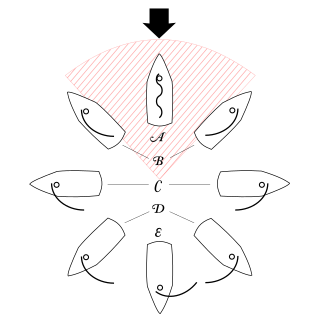
A point of sail is a sailing craft's direction of travel under sail in relation to the true wind direction over the surface.

A centreboard or centerboard (US) is a retractable hull appendage which pivots out of a slot in the hull of a sailboat, known as a centreboard trunk (UK) or centerboard case (US). The retractability allows the centreboard to be raised to operate in shallow waters, to move the centre of lateral resistance, to reduce drag when the full area of the centreboard is not needed, or when removing the boat from the water, as when trailering. A centreboard which consists of solely a pivoting metal plate is called a centerplate. A daggerboard is similar but slides vertically rather than pivoting.
Benjamin Lexcen AM was an Australian yachtsman and marine architect. He is famous for the winged keel design applied to Australia II which, in 1983, became the first non-American yacht to win the prestigious America's Cup in 132 years.

A leeboard is a form of pivoting keel used by a sailboat largely and very often in lieu of a fixed keel. Typically mounted in pairs on each side of a hull, leeboards function much like a centreboard, allowing shallow-draft craft to ply waters fixed keel boats cannot. Only the leeward side leeboard is used at any time, as it submerges when the boat heels under the force of the wind.
A bilgeboard is a lifting foil used in a sailboat, which resembles a cross between a centerboard and a leeboard. Bilgeboards are mounted between the centerline of the boat and the sides, and are almost always asymmetric foils mounted at an angle to maximize lateral lift while minimizing drag. They are most often found on racing scows.

In sailing, hiking is the action of moving the crew's body weight as far to windward (upwind) as possible, in order to decrease the extent the boat heels. By moving the crew's weight to windward, the moment of that force around the boat's center of buoyancy is increased. This opposes the heeling moment of the wind pushing sideways against the boat's sails. It is usually done by leaning over the edge of the boat as it heels. Some boats are fitted with equipment such as hiking straps and trapezes to make hiking more effective.
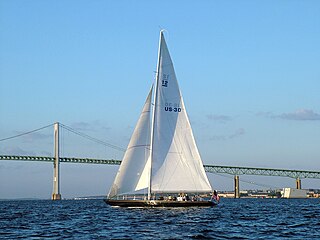
The 12 Metre class is a rating class for racing sailboats that are designed to the International rule. It enables fair competition between boats that rate in the class whilst retaining the freedom to experiment with the details of their designs. The designation "12 Metre" does not refer to any single measurement on the boat, and is not referencing the vessels overall length, rather, measures the sum of the components directed by the formula which governs design and construction parameters. Typically 12 Metre class boats range from 65 to 75 feet in length overall; they are most often sloop-rigged, with masts roughly 85 feet tall.
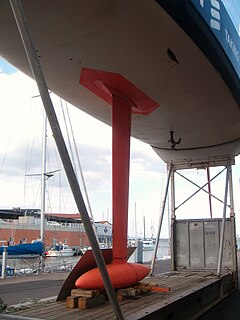
A canting keel is a form of sailing ballast, suspended from a rigid canting strut beneath the boat, which can be swung to windward of a boat under sail, in order to counteract the heeling force of the sail. The canting keel must be able to pivot to either port or starboard, depending on the current tack.

A sailing hydrofoil, hydrofoil sailboat, or hydrosail is a sailboat with wing-like foils mounted under the hull. As the craft increases its speed the hydrofoils lift the hull up and out of the water, greatly reducing wetted area, resulting in decreased drag and increased speed. A sailing hydrofoil can achieve speeds exceeding double and in some cases triple the wind speed.

A sailing yacht, is a leisure craft that uses sails as its primary means of propulsion. A yacht may be a sail or power vessel used for pleasure, cruising, or racing. There is no standard definition, so the term applies here to sailing vessels that have a cabin with amenities that accommodate overnight use. To be termed a "yacht", as opposed to a "boat", such a vessel is likely to be at least 33 feet (10 m) in length and have been judged to have good aesthetic qualities. Sailboats that do not accommodate overnight use or are smaller than 30 feet (9.1 m) are not universally called yachts. Sailing yachts in excess of 130 feet (40 m) are generally considered to be superyachts.
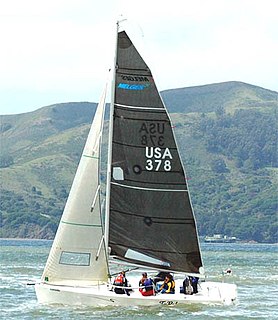
The term sportsboat first appeared in the late 1980s and early 1990s to describe trailer sailers that were optimised for high performance at the expense of accommodation and ballast. The very definition of the term "sportsboat" is evolving.

High-performance sailing is achieved with low forward surface resistance—encountered by catamarans, sailing hydrofoils, iceboats or land sailing craft—as the sailing craft obtains motive power with its sails or aerofoils at speeds that are often faster than the wind on both upwind and downwind points of sail. Faster-than-the-wind sailing means that the apparent wind angle experienced on the moving craft is always ahead of the sail. This has generated a new concept of sailing, called "apparent wind sailing", which entails a new skill set for its practitioners, including tacking on downwind points of sail.
The 1983 Louis Vuitton Cup was held in Newport, Rhode Island, United States in 1983. The winner, Australia II, went on to challenge for the 1983 America's Cup.
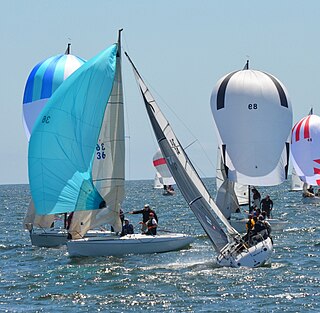
Forces on sails result from movement of air that interacts with sails and gives them motive power for sailing craft, including sailing ships, sailboats, windsurfers, ice boats, and sail-powered land vehicles. Similar principles in a rotating frame of reference apply to wind mill sails and wind turbine blades, which are also wind-driven. They are differentiated from forces on wings, and propeller blades, the actions of which are not adjusted to the wind. Kites also power certain sailing craft, but do not employ a mast to support the airfoil and are beyond the scope of this article.

Australia (KA–5) is an Australian 12-metre-class America's Cup racing yacht that twice challenged unsuccessfully for the America's Cup in 1977 and 1980. Designed by Ben Lexcen in association with the Dutch designer Johan Valentijn for Alan Bond, Australia failed to win a single race against the 1977 defender, Courageous (US-26), but won one race against the 1980 defender, Freedom (US-30). Australia resides in Sydney, Australia.
The Hunter 18.5 is an American trailerable sailboat that was designed by the Hunter Design Team as a cruising sailboat and first built in 1987.